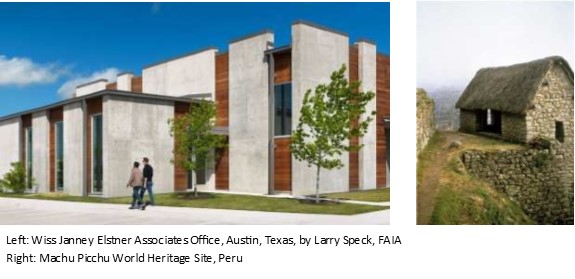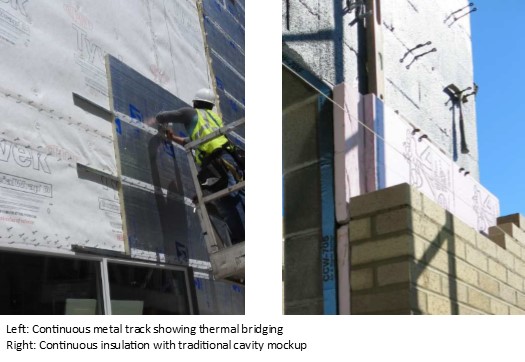|
In the 1990s, the American Institute of Architects (AIA) National formed the Technical Committee; this group of architects focused on the technical aspects of building design. By May 2004, this committee became known officially as the Building Enclosure Council (BEC), a joint committee of the AIA and the Building Enclosure Technology & Environmental Council (BETEC) of the National Institute of Building Sciences (NIBS). The initial goal of the memorandum of agreement between the two was to establish at least nine local BECs by May 2007. The goal was exceeded. Today, there are nearly 30 councils throughout the country that operate through regional or state AIA chapters. The BECs brings together a cross section of professionals interested in meeting the challenges of designing and constructing higher performance buildings, improving energy efficiency, and resolving technical building science issues associated with local weather conditions. This diverse multi- discipline group includes architects, engineers, contractors, envelope consultants, building scientists, educators, researchers, manufacturer reps, and building owners; together they promote the exchange of information and encourage discussions through educational programs.
Once a year, the BECs gather nationally for an all-day symposium to present and discuss the latest building enclosure topics. In May 2016, BEC-Austin had the honor of being the host city. Their “Perspectives on Building Enclosures” Symposium began with Larry Speck, FAIA, walking us through “Historical Perspectives on Building Enclosures.” His talk generated interest as we examined architectural history through the building enclosure. We examined how we can increase building performance by learning from generations-old structures, and then evaluated current practices to see if they are, in fact, best practices. While many architects are interested in the layers of materials used to create with continuous insulation, air, and weather barriers, Larry asked us to consider what’s wrong with long-standing walls that optimize simple wall construction, such as the use of thermal mass type walls. He pointed out that single-material walls, without any insulation, performed well as a thermal mass. Obviously, location makes a difference; his contemporary building examples were in Austin, Texas, including an office building that he worked on for Wiss Janney Elstner Associates.

The next session was presented by Dr. John Straube, PE, an experienced building scientist who teaches, writes, consults, and performs research on energy efficient, healthy, durable, and sustainable building enclosures. He is both a Principal at RDH Building Science, Inc. and an Associate Professor in the Department of Civil Engineering and the School of Architecture at the University of Waterloo. His topic, “A Building Scientist’s Perspective on the Building Enclosure” discussed the need for better metrics when designing higher thermal resistance into our new and existing buildings.
I had heard Dr. Straube lecture on several other occasions, this time, a few of his comments began to resonate with me. He noted that while the use of continuous air barrier is a good start; it is controlling airflow that can be more important as air contributes to a significant loss of energy in both hot and cold climate zones. Air flows through the walls, within the and by the wind, so as we increase the thermal resistance of our assemblies, we also need to increase air tightness and yet he noted that we have limited methods available to test for air tightness!

Dr. Straube discussed how heat flow through our building envelopes is an important part of the future of our buildings. He noted that higher R-value walls, for example, are required to create better energy efficient buildings, but was quick to also note that R-value alone is not the best method to measure good enclosures.
While R-value is commonly used to measure thermal control of insulation, there are many other factors that influence the heat flow, namely, the impacts of temperature, thermal bridging, air leakage, and defective installations.
The multitude of these factors, working together, will ultimately deliver buildings with improved thermal control. He reminds us that when measuring the heat loss or gain through our building envelopes; they must be measured by using the whole-wall R-values and provide higher levels of air tightness, and comfort. “True R-value” is what is actually required to measure the building’s performance, but according to Dr. Straube, this is not yet developed as a scientific measure. As one of the leading edge building scientists, researching energy-related building performances, he is hoping that better metrics can be established in the future for performance measurement. Relying on basic standards or simplified assumptions is not going to improve our understanding of building science or buildings.

The lunch break session included University of Texas at Austin, NPR radio co-hosts, Dr. Art Markman and Dr. Bob Duke, who had us “Thinking About This,” which questioned our thought process and whether it inhibits or enhances our ability to make decisions. They wondered how we evaluate, design, and construct environments that consist of complex building materials and systems. They asked if we have sufficient knowledge in how the environments that we create affect the occupants and users of those environments. They suggested that the way our brain processes information may assist us in deciding whether we continue delivering buildings the way we have always done or if we join the voices that advocate for change?
They provided insights into understanding how our brains work so that we can better manage our daily decision-making and better manage the changes that our industry needs. When trying to solve a problem, Markman and Duke recommend asking your memory a different question; getting up, walking around, and talking to others will help recall or release information that may have been pushed to the back of your brain. They also noted that to successfully find solutions to your problems, you need to find motivated people who share the same spirit of new ideas. Roadblocks or people who will not budge do not help our ability to create better solutions in our environments.

The afternoon sessions included a panel discussion about Building Enclosure Commissioning (BECx) and who is qualified to perform the commissioning. The expert panelists included Michael Clippinger, National Director of Quality at JE Dunn; Fiona Aldous, Principal at Wiss Janney Elstner Associates; Rob Kistler, AIA, Principal of the Façade Group, LLC; and Dr. John Straube, PE, Principal of RDH Building Science, Inc.
More recently, BECx has become known as a means to achieve a high performance building enclosure while providing a means to earn additional LEED points. The design and construction industry notes that there is confusion and strong debate over how building enclosure commissioning is defined, how it is achieved, and who is qualified to perform it. The panel of BECx national leaders spent time discussing these key concerns and where they see BECx heading in the future. Several panelists emphasized that the architect’s key focus regarding Building Envelope Commissioning should begin with providing appropriate details for the building envelope with the continuous air barrier and insulation, especially, as we can’t expect the envelope to be constructed correctly if we haven’t provided the details. The discussion also noted the need to establish the Owner Program Requirements (OPR) early in the design process. Team collaboration was also mentioned with the goal for everyone to understand their role and responsibility, whether you’re the engineer doing the thermal or energy modeling, or the architect creating the details, or the specifier writing about the performance requirements. One panelist concluded that the BECx can be considered a tool to assist the owner; it can be used to confirm that the envelope meets the design intent, but to date it is not a requirement on most projects.
The day ended with Global Director of Building Sciences at Owens Corning, Dr. Achilles Karagiozis, talking about enclosure design from the perspective of hygrothermal analysis. He noted that building science deals with designing for both durability and human comfort. He also noted that we need to look at how to achieve zero net energy buildings as clients and owners are demanding enclosures that align with outcomes of high thermal comfort with reduced energy costs and increased durability. To achieve these goals, project teams must design with an understanding of how moisture accumulates in modern material assemblies and how our designs must avoid thermal bridging through the use of continuous insulation and air barriers.
The amazing focus of the BECs is that we – a multi-discipline group of members located in many parts of the country – are continuing to discuss the building science issues associated with the enclosures to provide our clients and building owners with higher performing buildings that meet their needs.
Join us in 2017 when BEC-Greater Detroit hosts our next BEC National All-Day Symposium. However, we hope that you won’t wait for a National BEC Symposium to learn more. Kindly reach out to your local AIA chapter for a listing of BEC meetings and presentations in your region. Check out the list of BECs on the NIBS website and on the AIA website to become engaged in designing and constructing buildings.
This article was written by Cheryl Smith, AIA, LEED AP, and Principal at Cope Linder Architects. She is the AIA/BETEC Liaison, a member of the Technical Design for Building Performance AG, and Co-Chair of BEC-Philadelphia and the BEST 5 Conference in 2018.
|